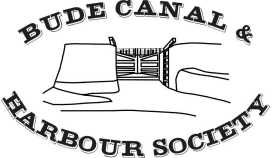|
EXETER
IDYLL
Part 1 Walking round Exeter
On July 16th an almost full coach left Bude arriving at Exeter Wharf at
10.25am. Two volunteer City Guides took us in two separate parties round
this historic part of the city which is Roman in origin so this was a
history lesson made the more interesting by the enthusiasm of our guides.
We were reminded that serge wool was exported to Holland, that the mill
on the Exe was once a paper mill, and that the weir was built so that
small boats could go through.
Standing in front of the Custom House we were told that its history links
with the Great Fire of London. After that event no wooden buildings were
built and the Custom House was the first commercial brick building in
the city of Exeter.
The River Exe has its source about 35 miles away on Exmoor and the flood
defence system was built after the floods in the 1950s. We walked over
the iron bridge built in that period. The green iron lamp standards along
the riverside have been restored after being dumped and are the only items
now remaining after several centuries.
The arches in the wall by the river which now house various shops are
60ft deep and during the second world war were used as air raid shelters
and for storing petrol. We were reminded that James Green of Bude Canal
fame lived in Exeter.
In 1831 the basin was constructed so that barges could wait for the river
level to drop and then unload their cargoes. As we walked over the suspension
bridge above Trews weir we stopped to look at the flood defence system.
If the river overflows, the water escapes over the concrete wall into
marshland.
On the other side of the bridge we walked through Belle Isle park, originally
a sewage works, noting that no games or dogs are allowed therein!
A large house dating from the 18th century was pointed out to us further
along and above the river. This had been Trews Mill, a woollen mill and
then a cotton mill employing over 300 people when it was busy. In the
20th century it became a paper mill and among the items it printed were
tickets for the London Underground.
Moving on again we were enthralled by the story of a typhoon which swept
the area on the 14 September 1850 taking boats from the river into nearby
fields - and the Illustrated London News of the time printed photos of
the event (our guide produced photocopies for all to see)
The ferry was re-built in 1990 by public request for it to be re-instated.
Now Butts Ferry is a very popular way to cross the river - at a cost of
20p - so if your Shanks' pony wants a rest, this is the answer.
A big thank you to our volunteer guides for making this historic walk
so very interesting. Lunch followed at various venues round the Wharf.
Jill White
back
to contents
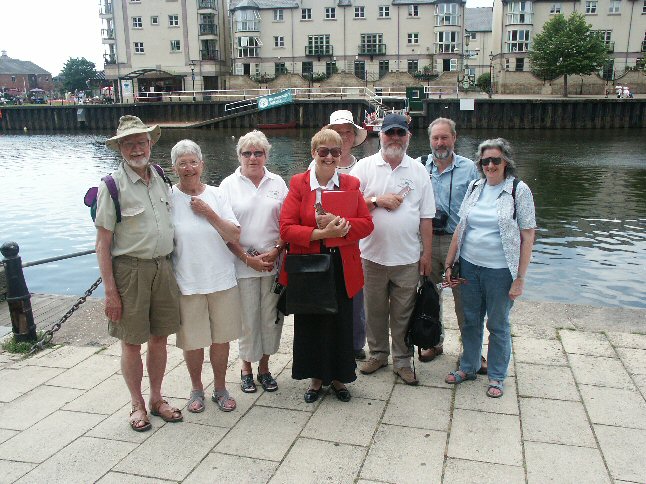
Part
2 To Exmouth By Water
The Exeter canal is England's oldest locked canal. Built between 1564
and 1566, it predates the canals of the great canal - building era by
about 200 years and Bude canal by more than 250 years!
In common with many other later canal enterprises, the need to by-pass
a difficult river navigation was the spur to the creation of a canal on
which trade could pass unhampered by weirs, shoals and tiresome landowners.
Exeter's rich trade was in wool so easy access to the sea was all-important.
The first canal, running as now, parallel to the river, was 16ft wide
by 3ft deep, but in the early 18th century was enlarged to the ship canal
dimensions we know today, approximately 14ft deep by 30ft wide. The engineer
commissioned to dredge, straighten and generally enhance the canal in
1818 was none other than our own James Green whose improvements included
extending the canal to Turf where his entrance lock from the Exe estuary,
131ft by 30ft 3ins enabled ships of 14ft draught and 400 tons to navigate
up to Exeter; the canal having previously terminated at Topsham lock.
The canal today is much as James Green left it in 1832, further testimony
to his canal-building genius.
The wonderful trip on which we were now about to embark was the second
half of the day in Exeter, the first half of which you have just read
about. After lunch, partaken at various venues in and around the old docks,
we set out to find our boat. It wasn't difficult. Confronting us at the
river's edge looking more like an open-topped, double-decker London bus
than the modest river trip boat we expected, was our vessel for the voyage
to Exmouth; the colour was right too! This enormous craft, the Pride of
Exmouth, had travelled up from Exmouth earlier that morning with passengers
Exeter-bound, as it does regularly on a few permitted occasions during
the summer. Exeter City Council not being renowned for their enthusiasm
for usage of their canal, these occasions are few & far between and
well worth enquiring about. Despite the presence of the return passengers
there was still room for our mob (just), all vacant seats inside and on
top soon taken and an extremely top-heavy looking vessel cast off from
the river side for the passage down river and canal to Exmouth.
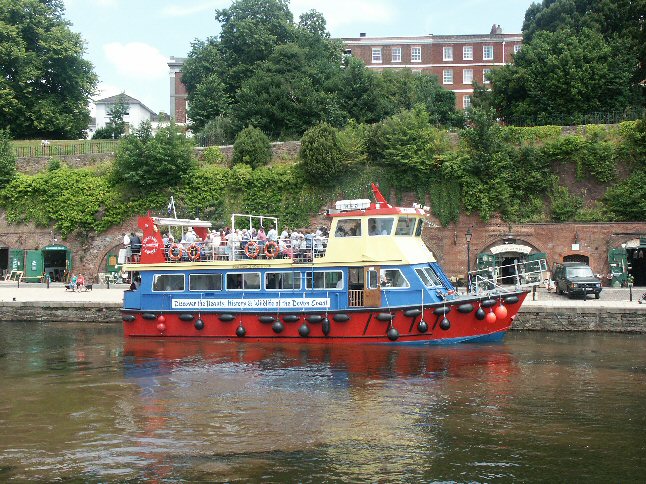
The entrance to the Exeter canal is situated downstream of the river docks
adjacent to the canal basin and accessed through a narrow flood-lock and
swing bridge. From the canal and our vantage point on the top deck of
our huge boat, we had excellent views behind us of Exeter Cathedral atop,
as-it were, the city itself, the canal basin choc-a-bloc with moored craft
of all types, and the old river docks from which we had just cast off.
To the right were old buildings of the trading era, among them the Welcome
pub, much beloved of the boatmen of an earlier age and still patronised
by today's more affluent younger generation. To the left were the comparatively
recent flood defences between river & canal, an enormous concrete
over-spill weir for when the river is in full spate and channels alongside
to disperse the water into the wide valley.
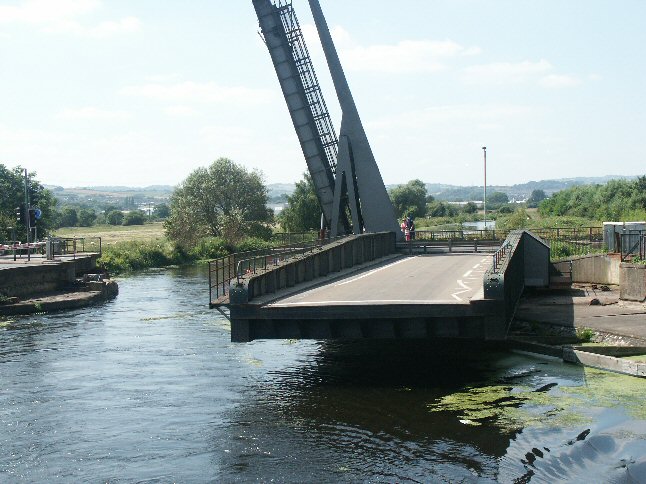
After a further swing bridge or two, we approached Double Locks (once
three locks before the 18th century widening) and now a single large lock
designed to act as a passing place. This lock is electrically operated
and here it became apparent to those of us high above the towpath, that
Exeter City canal employers were accompanying us on our trip downstream
in order to swing the bridges and operate the mechanism for the locks;
prominent among them being Mr Nott the canal manager.
Not long after leaving Double Locks, we saw ahead, the canal's most famous
(or notorious) obstacle to navigation (or motoring) according to one's
viewpoint! This is the impressive Countess Wear Bridge - two of them actually,
one, the newer, a massive lift bridge and the other, the original swing
bridge, both electrically operated. As we approached we could hear the
warning siren sounding, saw the traffic lights turn red, the heavy traffic
slow to a halt and the barriers descend. Almost simultaneously one bridge
began to lift and the other to swing allowing our boat to pass majestically
through. All aboard waved enthusiastically to the line of stationary cars
disappearing into the far distance but strangely, no one seemed disposed
to reciprocate our friendly signals.
Double locks negotiated, we resumed the journey through green fields and
soon ahead, could see the vast span of the M5 motorway crossing everything
in sight, river, railway, canal, valley, the lot from East to West. Before
long, Topsham was visible across the ever-widening river and it was possible
to see signs of the links between Topsham and the canal, in particular
Topsham Lock, James Green's 18th century contribution before the lengthening
to Turf. The lock is in a parlous state, alas, but its original toll house
is still in place on the lockside.
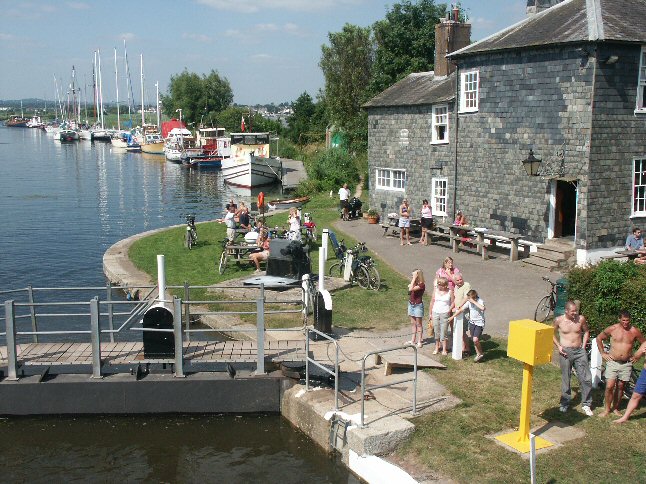
On then to Turf and into the lock and down into the estuary, water, sand,
boats, birds and beautiful scenery all around. The Exe estuary, in places
a mile & a half wide, reaches the sea through a narrow opening between
Exmouth and Dawlish Warren. The weather conditions granted to us for this
marvellous voyage ensured good visibility and sunshine throughout and
the brisk sea breeze which sprang up in mid stream was quite a bonus.
The channel was marked throughout by coloured buoys which enabled one
to appreciate the winding course of the river hereabouts. Boats of all
description abounded though ours was the largest by several feet in all
directions!
We docked near the esplanade in Exmouth, dispersing briefly for refreshments
and exploration before meeting at 6.30pm for the coach trip back to Bude.
This had been an outstanding outing, well attended in good company and
marvellous weather to boot. What more could one ask for? All congratulations
and thanks to Betty Moore and Chris Jewell for the impeccable organization
and hard work that went into it all.
Audrey Wheatley
back
to contents
Bude
Canal Regeneration Project
Funding has now been secured for the Development Phase of the project
which is due to be completed by the end of April 2006. South West England
Regional Development Agency, Heritage Lottery Fund, and Objective 1 have
contributed a total of £248,100. SWERDA & HLF funding for the
final phase of implementation has been "ring-fenced". Objective
1 funding has not been secured and will have to be bid for, competing
with other projects in Cornwall.
However, progress is being made by the appointment of a Project Manager,
Ian Mander, a civil engineer with a wide range of experience, and an assistant
Project Manager, Andrea Vaillancourt-Allder, with experience of canal
regeneration and HLF projects.
The Development phase requires detailed work on design as required by
planning permissions and specific work as required by HLF. Additionally,
work has to be done on developing the strategy for bridges, locks, dredging,
building work, roads, flood profiling, interpretation, education, marketing,
and access. Briefs for this work have been sent out to various consultants
and it is hoped that by the end of October 2005 the appointments will
have been made.
Other work has to be done in relation to abstraction licence, fish pass
and pond, business data, agreements i.e. acquisition of or access to canal
associated historic structures, development of canal partnership, training
plan, and long term management plan.
The Development phase is due to be completed by the end of April 2006.
The implementation phase, subject to the receipt of the second stage funds,
has to be finished by May 2008.
Throughout the Development Stage the project time will ensure that as
wide a consultation as is possible will take place.
There is a lot of work to be done but I am sure that this project will
be implemented for the benefit of residents and tourists alike.
Chris Jewell
back
to contents
Intereg
Walking Routes Project
This project
is well under way. The Bude Valley Walks (Bude - Helebridge and adjoining
walks) has been signed and the booklet produced.
The Canal & Coast circular walk is progressing. The footpath along
the feeder arm (Bude Aqueduct) has become a public right of way (PROW)
through an agreement between Devon County Council and the owners, Bude
Canal Trust. The complete circular route, except for a short section at
Burmsdon, Launcells is basically agreed. The lack of the Burmsdon section
means the feeder arm section remains a linear route and the Bude end may
have to be a shorter circular route returning via Launcells and Stratton.
The progress on the Launceston arm down the Tamar valley is more difficult.
Landowners are reluctant to agree in sufficient numbers to achieve a continuous
route. There are no PROWs in the Tamar valley which would allow some alternative
routes to link with sections that could be accessed.
The Holsworthy area is also difficult as much of the canal no longer remains.
It is hoped that some circular routes can be achieved by using PROWs with
other agreed access. Efforts are also being made to create walking routes
from Tamar Lakes to Bradworthy and Holsworthy. If achieved these routes
would link into existing 'Ruby Country Trails'. These are part of a massive
initiative by Torridge District Council and Devon County Council to revitalise
the rural economy by creating new routes combined with existing routes
for walkers, cyclists, and horse riders.
A key cycling route is the use of the former railway from Holsworthy to
Bude. This route would pass two important canal sites at Merrifield, near
Bridgerule and Helebridge, near Marhamchurch. To highlight the value of
the walking routes on the tub boat canal sections and give greater awareness
of the significance of the tub boat canal, NCDC's Coast and Countryside
service, with Bude Canal Trust and this Society are working on a Tub Boat
Canal Exhibition, "The Hidden History" which will be held on
19th-21st November 2005 at the Parkhouse Centre. It is hoped also to take
this exhibition to rural areas in the weeks to follow but this has yet
to be finalised.
Chris Jewell
back
to contents
Virworthy
View
Looking back on my 19 issues of Virworthy View I seem to be preoccupied
with the weather. Well I'm not going to bore you with it this time, suffice
it to say after a wet warm winter and a fairly dry summer the flora is
bigger and better than before! There is also an abundance of berries,
so much so that I have been tempted to pick sloes and make some sloe gin.
I am told that after the gin is siphoned off, adding brandy to the remaining
sloes makes a good brew!
One day I engaged three walkers in conversation who told me they had just
seen a turtle in the lake! I smiled and nodded politely and continued
my walk with the dogs. Being a sceptic, I proceeded to the lake and scanned
the water around the bridge and to my surprise there was a turtle. It
was about ten inches across its back and twelve inches long. It had bright
orange and yellow stripes on its head and what looked like a light coloured
underside. I have not yet had a positive identification. I have seen it
several times since but only when the water is calm with the sun on it.
With the extensive blue/green algae on the water just now it may be lucky
to survive.
Progress is being made on opening the towpath as a public right of way
(PROW). This means that maintenance work to keep the path open will be
carried out by Devon County Council. Work has now started on repairs to
culverts and the renewal of gates and stiles. This will make an uninterrupted
walk from one end to the other and allow unimpeded progress for mowers.
Geoff Lowe
back
to contents
Fund-raising
Bude Canal Day on 24th July in conjunction with Bude/Stratton Town Council's
Gurney Day, was on the whole a success although the weather was not as
kind as it might have been at times. It allowed us to set up the marquee
and sales gazebo, transport tables and chairs to the site, and set up
displays and goods for sale. The musicians performed and the canoeists
played polo and other participants did their 'thing'. The canoe competition
for the BCHS shield was won by Bude Canoe Club 'A' team and the runners-up
were the same club's 'B' team. The trophy was presented to the winning
team by BCHS Chairman, Mrs Audrey Wheatley.
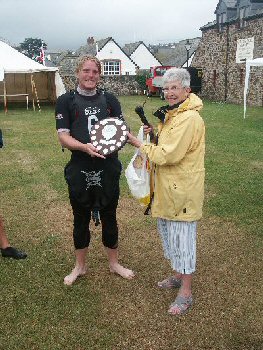
Unfortunately, several heavy showers accompanied by a chilly wind discouraged
passers-by and damaged some of our stock of leaflets and books.
My thanks to my fellow trustees and members Barry Garvie, Deputy Mayor
of BSTC, and Paul Finn for their valuable assistance with the erection
of the marquee, and to Rolle Canal and Northern Devon Waterways Society,
Grand Western Canal Trust, Old Cornwall Society, North Devon Maritime
Museum, SW Lakes Trust, Environment Agency and North Cornwall Coast &
Countryside Service for their participation in this event.
Plans are afoot even as I write for Canal Day 2006. Further details in
the next edition of "The Tub Boat"
Chris Jewell
back
to contents
Carnival
Day and RNLI Weekend
In addition
to the above your committee erected and manned our stall on the Castle
green on Carnival day, and on the Bark House green on the Saturday and
Sunday of RNLI weekend.
The Saturday was overcast and sales were sporadic but the Sunday was warm
and sunny all day and sales were much better. We also manned a stall provided
by the organisers of a general charity day on the triangle in August.
Overall, about £450 was made from these projects. It is worth doing
not only for the money made towards Society funds but for making the Society's
name known.
Editor
back
to contents
North
Devon Maritime Museum -
Trafalgar Weekend

This
will be held on 21st to 23rd October with an exhibition at St Mary's Church
Hall, Appledore.
Commodore Noel Preston-Jones will open the exhibition and sea cadets will
carry out a gun drill with a full-scale replica of a ship's cannon. There
will be many other activities, including talks on Nelson and Napoleon,
a Marine War Game, a CD containing biographical details of all 21,000
men serving in the Royal Navy at the battle.
Blagdonmoor
Wharf
The following is a slightly edited version of an article
published in "Waterways World", reproduced with their permission.
After years
of working in the very demanding field of management accounting, Dermot
O'Neill decided he had had enough of the rat race. In 1991 he thought
it was time to fulfil a lifelong dream and he sailed the Atlantic singlehanded.
In the Virgin Islands he met Caro, who became his wife, and they sailed
back across the Atlantic together and settled in Spain.
After ten years, and with two growing boys, the couple decided to move
back to the UK to be near Caro's parents who farmed in Cornwall. Looking
to invest some money towards a pension, the couple looked for a project
that was environmentally attractive and settled on buying 35 acres of
what Dermot describes as "some of Devon's less sought after land"
near Blagdonmoor Wharf which was the terminus of the Holsworthy Arm of
the Bude Canal.
"We planted 15 acres to woodland and realised that a wet hollow simply
cried out to be flooded" Dermot told WW. "That's why we created
the 3-acre 'Blagdon Water', which we stocked with fish. One day we were
looking at an old Ordnance Survey map and discovered that the Bude Harbour
& Canal Company had built a trail from Blagdonmoor Wharf to our land
for the purpose of transporting mineral-rich sand from the canal tub boats
to improve the farm land."
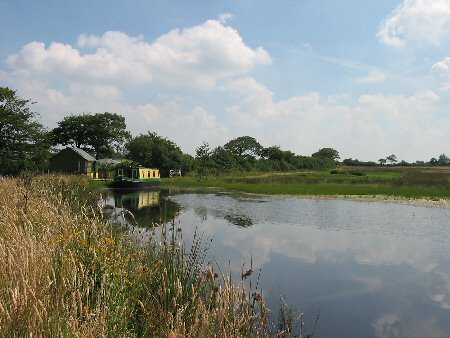
"North west Devon reminds me of parts of my native Ireland. The peace
and solitude of the area is wonderful, and we thought it would be a good
idea to start a small holiday business. The local council were not keen
on wooden chalet-type buildings and so we put Bude Canal plus lake plus
boats together, and came up with the idea of a static house boat."
With their wide experience of boats, and after scouring the pages of WW,
the couple approached a boatbuilder in Falmouth who built them Painted
Lady, a 50ft x 8ft 6in barge. "Without the engine room and stern
gear we were able to incorporate two very comfortable cabins, both with
en-suite toilet and shower. The aft cabin offers a double bed while at
the other end of the boat the twin cabin has two full-size single beds."
Coincidentally the boat is a similar size to the barges, which traded
on the two-mile section of Bude Canal between Bude and Helebridge Wharf
until its closure in 1891. The other 35½ miles of the canal used
inclined planes rather than locks and was therefore only accessible by
tub boats.
Funding has just been approved for the first stage of the Bude Canal Regeneration
Project, which envisages reopening the two inland locks on the barge section
to allow navigation from Bude to Helebridge. The Bude Sea Lock was refurbished
in 2000 to give sea-going boats access to the lower basin of the canal.
"This really is a dream come true for us" Dermot continued.
"I am in a hurry to see the site mature, and I want my woodland now,
but that's not possible of course. In the meantime the lake and the rapidly
evolving environment are proving to be very rewarding. One day spent working
on the land is worth a hundred spent cooped up in a corporate office!"
For further details of this unusual holiday opportunity in the West Country
call 01566 779830, or visit: www.blagdonwater.com.
Mike Moore
back
to contents
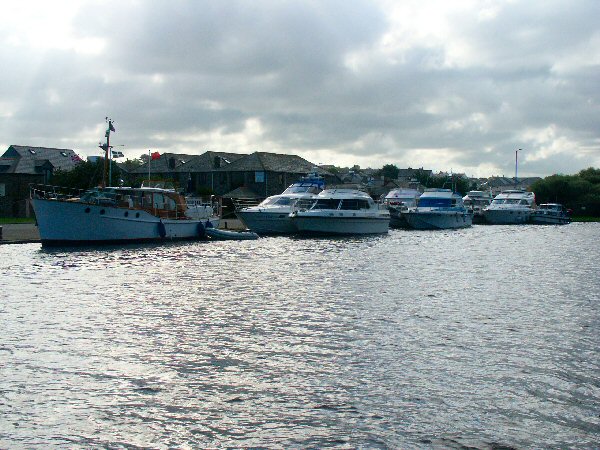
Membership
Report
We welcome the following new members who have joined since the last Tub
Boat, Mr B E Leonard, Efford Down House, Bude and Mr G Howes, Belle Vue
Avenue, Bude.
As many of you will realise, this is the time of the year when I have
to remind you that subscriptions were due on 1st September for all members
except those who joined after 1st May. Renewal forms (where appropriate)
are included with this newsletter. Members are encouraged to return the
standing order form to me as it is a more efficient method of payment
for the society and avoids your renewal being overlooked. Membership cards
will automatically be sent to members who have already completed standing
order mandates. May I also remind those members who are taxpayers and
who have not completed a Gift Aid declaration that they can obtain a copy
from the Treasurer.
Mike Moore, Membership Secretary
Forthcoming
Events:
Tuesday
18th October
Presentation by James Griffin, 'The Voyages of "Ocean Princess"
7.30pm Parkhouse Centre, Bude
Fri 21st
- Sun 23rd October
North Devon Maritime Museum - Trafalgar weekend
Sunday 12th
November
Charity Bazaar Parkhouse Centre, Bude - 11 am to 2 pm
Sat/Mon
19th/21st Nov
"The Hidden History" Exhibition, Parkhouse Centre, Bude
Sunday
18th December
It's A TRADITION - THE MINCEPIE WALK - 11am at the Sea Lock to Barge workshop
back
to contents
|
